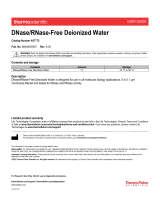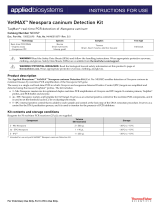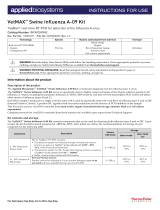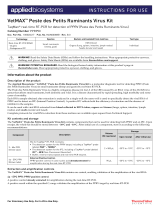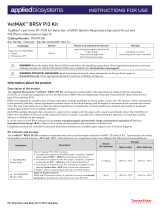Page is loading ...

For Veterinary Use Only. For In Vitro Use Only.
INSTRUCTIONS FOR USE
VetMAX™ Ruminant Respiratory Screening Kit
TaqMan® real-time RT-PCR for detecting 7 major pathogens that cause respiratory diseases in
ruminants (Mycoplasma bovis, Histophilus somni, Pasteurella multocida, Mannheimia haemolytica, bovine
Coronavirus, bovine respiratory syncitial virus, bovine
parainfluenza
-3 virus)
Catalog Number SRPR
Doc. Part No. 100020443 Pub. No. MAN0008879 Rev. B.0
Technology Species Nucleic acid isolated from matrices Test type
Real-time RT-PCR (DNA/RNA)
– 7 duplex
– Endogenous IPC
Bovine
Nasal and tracheal swabs
Tracheal and bronchoalveolar fluid
Lungs
Individual
WARNING! Read the Safety Data Sheets (SDSs) and follow the handling instructions. Wear appropriate protective eyewear,
clothing, and gloves. Safety Data Sheets (SDSs) are available from thermofisher.com/support.
WARNING! POTENTIAL BIOHAZARD. Read the biological hazard safety information at this product’s page at
thermofisher.com. Wear appropriate protective eyewear, clothing, and gloves.
Information about the product
Description of the product
The Applied Biosystems™ VetMAX™ Ruminant Respiratory Screening Kit is a molecular diagnostic tool for detecting the agents that
cause the principal respiratory diseases in bovines (M. bovis, H. somni, P. multocida, M. haemolytica, bovine Coronavirus, bovine
respiratory syncitial virus, bovine parainfluenza 3) by real-time PCR.
Each nucleic acid sample obtained after extraction is analyzed in 7 single wells; each well is used to specifically detect the nucleic acid
of the pathogen in question and an IPC (Internal Positive Control). A positive IPC reflects both the efficiency of extraction and the
absence of inhibitor in the samples.
It can be used on nucleic acid extracted from nasal and tracheal swabs, and tracheal, bronchoalveolar and lung fluids.
Complete protocols for nucleic acid extraction from these matrices are available upon request from Technical Support.
Kit contents and storage
The VetMAX™ Ruminant Respiratory Screening Kit contains components that can be used for detecting these 7 pathogens and an
IPC. Upon receipt, the whole kit should be stored at −30°C to −10°C. After initial use of a component, store it according to the
following recommendations:
Component Description Volume
(25 reactions)
Storage
Upon receipt After initial use
3 - Mix SRPR M. bovis
(Green tube)
7 mixes for TaqMan® RT-PCR. Each contains:
• The detection system for the pathogen target,
including a TaqMan® probe labeled FAM™ - NFQ
(Non-Fluorescent Quencher).
• The detection system for IPC, including a
TaqMan® probe labeled VIC™ - NFQ
(Non-Fluorescent Quencher).
• Buffer, reverse transcriptase and real-time
PCR enzyme.
500 µL −30°C to −10°C −30°C to −10°C
3 - Mix SRPR H. somni
(Yellow tube)
500 µL −30°C to −10°C −30°C to −10°C
3 - Mix SRPR P. multocida
(Blue tube)
500 µL −30°C to −10°C −30°C to −10°C
3 - Mix SRPR M. haemolytica
(Orange tube)
500 µL −30°C to −10°C −30°C to −10°C
3 - Mix SRPR Corona
(Red tube)
500 µL −30°C to −10°C −30°C to −10°C
3 - Mix SRPR RSV
(Black tube)
500 µL −30°C to −10°C −30°C to −10°C
3 - Mix SRPR bPI3
(Purple tube)
500 µL −30°C to −10°C −30°C to −10°C
4a - EPC SRPR
(Brown tube)
External Positive Control:
Positive control for 7 pathogens. It consists of
already extracted nucleic acid to be amplified
during real-time PCR.
360 µL −30°C to −10°C −30°C to −10°C

2 VetMAX™ Ruminant Respiratory Screening Kit Instructions for Use
Extraction and amplification controls
The VetMAX™ Ruminant Respiratory Screening Kit contains one control used to validate the amplification of nucleic acid.
4a - EPC SRPR: pathogen target positive control
Already extracted positive control to be amplified during real-time PCR.
For each pathogen, a positive result within the specified Ct range enables validation of the amplification of the pathogen target by
real-time RT-PCR.
Validation of nucleic acid extraction for each sample is done by detection of an endogenous IPC (Internal Positive Control), present in
each sample.
A positive IPC result with a compliant value in a sample validates the extraction of this sample, whether positive or negative for the
target pathogen: elimination of false negatives and verification of the inhibitor effect.
We recommend including two negative controls to confirm correct analysis:
NCS: negative extraction control
This control consists of reagents used in the extraction without addition of the sample (sample volume can be replaced by the buffer
used in the sample preparation or by DNase/RNase-free water) that undergoes the same treatment as the samples: nucleic acid
extraction and real-time RT-PCR.
A negative result from the pathogen target and endogenous IPC confirms the absence of contamination during the extraction and the
real-time RT-PCR.
NC: negative amplification control
This control consists of an amplification mix added to the plate during real-time RT-PCR preparation, as well as 5 µL of DNase/RNase-free
water to adjust the reaction to 25 µL.
A negative result for the pathogen target and IPC confirms the absence of contamination during real-time PCR reaction preparation.
Materials required but not provided
Unless otherwise indicated, all materials are available through thermofisher.com.
• Precision micropipettes (range of 1 µL to 1000 µL) with DNase/RNase-free filtered tips
• DNase/RNase-free water
• 1X TE buffer
• 1X PBS buffer
• A real-time PCR thermal cycler capable of detecting the following fluorophores:
- FAM™ (emission maximum: λ515 nm)
- VIC™ (emission maximum: λ554 nm)
• Optical-quality consumables compatible with the thermal cycler used:
– PCR 96-well plates, PCR strips (8 or 12 wells), microtubes or capillaries
– Suitable plate covers or caps for capping
Analysis procedure
The real-time PCR reaction volume is 25 µL:
• 3 - Mix SRPR Pathogen: 20 µL per analysis
• Extracted DNA: 5 µL per analysis and per mix
Extraction of nucleic acid
The nucleic acid must be extracted from the samples prior to real-time RT-PCR analysis.
NOTE: For information about extraction methods that are compatible with and validated for the VetMAX™ Ruminant Respiratory
Screening Kit, please contact Technical Support.
Preparation of the real-time RT-PCR
1. Create an analysis plan for distribution of the mixes and samples. Keep the positive control (EPC) away from the other samples if
possible.
2. For each mix used for the analysis:
a. Thaw the tube of 3 - Mix SRPR pathogen at 2°C to 8°C, on ice or on a refrigerated rack.
b. Mix the 3 - Mix SRPR pathogen tube by shaking gently, then centrifuge briefly.
c. Add 20 µL of 3 - Mix SRPR pathogen to each PCR plate well, PCR strip or capillary used.

VetMAX™ Ruminant Respiratory Screening Kit Instructions for Use 3
3. Add the sample and control nucleic acid to each reaction mix according to the pre-defined analysis plan:
Type of analysis
Component Sample volume
Sample for analysis
Nucleic acid extracted from sample 5 µL
Positive amplification control
4a - EPC SRPR 5 µL
Negative extraction control (NCS)
Extracted NCS 5 µL
Negative amplification control (NC)
DNase/RNase-free water 5 µL
4. Cover the PCR plate, PCR strips or capillaries with an adhesive plate cover or suitable caps.
Amplification by real-time RT-PCR
1. Create the following detectors on the thermal cycler:
Reporter Quencher
MB, HS, PM, MH, BCOV,RSV, BPI3
FAM™ NFQ (Non-Fluorescent Quencher)
IPC SRPR
VIC™ NFQ (Non-Fluorescent Quencher)
Passive reference: ROX
™(1)
(1) The fluorophore ROX™ must be entered for real-time RT-PCR analysis if the thermal cycler is capable of detecting it. For other thermal cyclers, the absence
of detection of this fluorophore does not compromise the real-time RT-PCR analysis.
2. Assign the corresponding pathogen detector and the IPC SRPR detector to each sample well used in the analysis.
3. Set up the following real-time RT-PCR program for the analysis:
Step repetitions Temperature Duration
Step 1
×1 45°C 10 minutes
Step 2 ×1 95°C 10 minutes
Step 3 ×45 95°C 15 seconds
60°C(1) 1 minute
(1) Collection of fluorescence data during the 60°C – 1 minute stage.
4. Place the PCR plate, the PCR strips or the capillaries in the thermal cycler and run the real-time RT-PCR.
Analysis of the results
Analysis of the raw data
Refer to the recommendations of the thermal cycler manufacturer for the analysis of the raw data.
1. Position the threshold limits separately for each target of the real-time RT-PCR.
2. For each detector, interpret the results according to the sample Ct values obtained as recommended below.
Validation
The test is validated if the following criteria are met:
Pathogen detector IPC SRPR detector Validation
EPC SRPR
Ct = Ct QC Pathogen of 4a- EPC SRPR ± 3Ct(1) Ct < 45 or Ct > 45(2) RT-PCR validated
NCS
Ct > 45 Ct > 45 Extraction validated
NC
Ct > 45 Ct > 45 PCR components validated
(1) Refer to the values listed in section 2.1 “EPC” of the Certificate of Analysis of the lot used for the test.
(2) The IPC value in the EPC should not be used for test validation.
Interpretation of results
For each sample analyzed, the results should be interpreted as shown below:
Pathogen detector IPC SRPR detector Interpretation
Ct < 45
Ct < 45 or Ct > 45 Pathogen target detected
Ct > 45 Ct < 45 Pathogen target not detected
Ct > 45 Ct > 45 Not validated(1)
(1) The sample will be returned as not validated due to the negative IPC.

thermofisher.com/support | thermofisher.com/askaquestion
thermofisher.com
5 October 2017
Procedure for handling non-validated samples
If the sample is not validated only with certain mixes:
1. Perform a new RT-PCR analysis on 5 µL of the pure nucleic acid sample, using the mixes in question.
2. For each mix, if the nucleic acid is positive for the pathogen or negative for the pathogen with a compliant IPC result, then the result
obtained is validated for that mix.
3. If the result is still not validated for certain mixes, dilute the nucleic acid as described below (in the case of a sample not validated for
all mixes), but only follow this procedure for the mixes involved.
If the sample is not validated for all mixes:
1. Dilute the nucleic acid of the non-validated sample at a 1:10 dilution in 1X TE buffer.
2. Perform RT-PCR analysis on 5 µL of this dilution.
3. If the dilution is positive or negative for the pathogen target with a compliant IPC result, the obtained result is then validated for the
mix in question.
4. If the result is still not validated for certain mixes, extract the sample again by prediluting it to 1:10 in a 1X PBS buffer before extraction
and retest all of the mixes involved.
Documentation and support
Customer and technical support
Technical support: visit thermofisher.com/askaquestion
Visit thermofisher.com/support for the latest in services and
support, including:
• Worldwide contact telephone numbers
• Order and web support
• User guides, manuals, and protocols
• Certificates of Analysis
• Safety Data Sheets (SDSs; also known as MSDSs)
NOTE: For SDSs for reagents and chemicals from other
manufacturers, contact the manufacturer.
Limited product warranty
Life Technologies Corporation and/or its affiliate(s) warrant
their products as set forth in the Life Technologies' General
Terms and Conditions of Sale found on Life Technologies'
website at www.thermofisher.com/us/en/home/global/
terms-and-conditions.html. If you have any questions, please
contact Life Technologies at thermofisher.com/support.
Laboratoire Service International (LSI) | 6 Allée des Écureuils | Parc Tertiaire du Bois-Dieu | 69380 Lissieu, France
Translated from the French Pub. No. MAN0008878 Rev. B.0.
The information in this guide is subject to change without notice.
DISCLAIMER: TO THE EXTENT ALLOWED BY LAW, LIFE TECHNOLOGIES AND/OR ITS AFFILIATE(S) WILL NOT BE LIABLE FOR SPECIAL, INCIDENTAL, INDIRECT, PUNITIVE,
MULTIPLE, OR CONSEQUENTIAL DAMAGES IN CONNECTION WITH OR ARISING FROM THIS DOCUMENT, INCLUDING YOUR USE OF IT.
Revision history of Pub. No. MAN0008879 (English)
Revision
Date
Description
B.0 5 October 2017
• Corrected the IPC probe to VIC
™
-NFQ (Non Fluorescent Quencher) on page 1.
• Updated to the current document template, with associated updates to the warranty, trademarks, and logos.
A.0
11 March 2014
Baseline for revision history
Limited Use Label License No. 460: PCR Veterinary Diagnostics. Notice to Purchaser: For veterinary diagnostic services including the reporting of such services for a fee and
for research purposes only. Human diagnostic uses require a separate license from Roche.
©2017 Thermo Fisher Scientific Inc. All rights reserved. All trademarks are the property of Thermo Fisher Scientific and its subsidiaries unless otherwise specified. TaqMan
is a registered trademark of Roche, used under permission and license.
/

